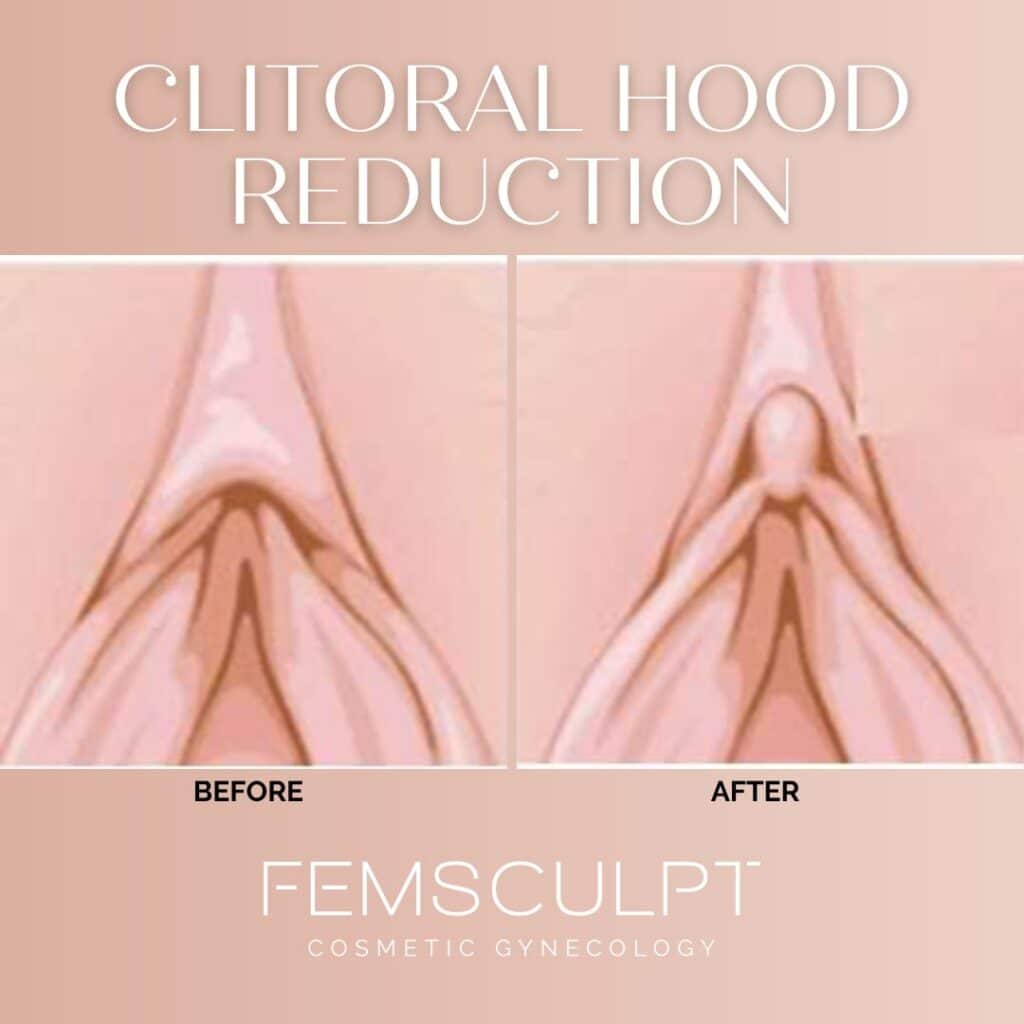If enhancing sexual well-being is a priority, it is important to consider hooded clitoris surgery, a procedure that can significantly improve both pleasure and comfort.
This surgical method involves the modification of excess tissue for individuals who believe their anatomical structure impedes intimacy. With the increasing focus on sexual health, such interventions are gaining popularity.

Considering whether this surgery is suitable involves evaluating its efficacy, safety, and postoperative expectations. A thorough understanding of the procedure can alleviate concerns and highlight the potential benefits it offers.
Table Of Contents:
- What is a Hooded Clitoris Surgery?
- The Hooded Clitoris Surgery Procedure
- Benefits and Risks of Hooded Clitoris Surgery
- Recovery and Results After Hooded Clitoris Surgery
- Clitoral Hood Reduction vs Other Procedures
- Candidates for Clitoral Hood Reduction
- Cost and Insurance Coverage for Clitoral Hood Reduction
- Conclusion
What is a Hooded Clitoris Surgery?
The clitoral hood is a fold of skin that covers and protects the clitoris, an organ with thousands of nerve endings crucial for sexual pleasure. However, for some women, the clitoral hood may be excessively large, posing challenges to sexual stimulation and satisfaction. Clitoral hood reduction, or hoodectomy, is a surgical procedure designed to remove excess skin from the clitoral hood to expose more of the clitoris.
The primary objective of this surgery is to enhance sensitivity and improve sexual gratification. By reducing the clitoral hood, the clitoris becomes more exposed and responsive to stimulation, potentially leading to increased arousal and more intense orgasms.
Beyond sexual benefits, women with a large clitoral hood may also experience physical discomfort or irritation from tight clothing. Clitoral hood reduction can address these issues, reducing discomfort and improving overall quality of life.
Should I Get Hooded Clitoris Surgery?
The decision to undergo clitoral hood reduction is highly personal. The procedure is best suited for women who perceive their clitoral hood as excessively large, which may lead to decreased sensation or physical discomfort. It is essential for candidates to have realistic expectations about the outcomes.
While clitoral hood reduction can enhance sensitivity, it should not be viewed as a panacea for sexual dysfunction or relational difficulties. Selecting a qualified and experienced surgeon like Dr. Sue Kafali is crucial to minimize potential risks and ensure the best possible results from the surgery.
Does a Hooded Clitoris Surgery Increase Sensitivity?
The short answer is that clitoral hood reduction can indeed enhance sexual response. By removing excess skin and exposing more of the clitoris, the procedure facilitates direct stimulation of this highly sensitive area. Many women report increased responsiveness and more intense orgasms following the surgery.
However, it is important to recognize that each woman’s anatomy and experience are unique. Some may experience a dramatic improvement, while others might only perceive a subtler change. While increased sensitivity is not guaranteed, it is a commonly reported benefit of this procedure.
The Hooded Clitoris Surgery Procedure
If you’re considering a clitoral hood reduction, you likely have questions about the procedure. What exactly happens during the operation, which may involve surgical or laser techniques? Clitoral hood reductions, or hoodectomy, are typically performed by plastic surgeons or gynecologists who specialize in female genital cosmetic surgery.
Choosing a board-certified surgeon, such as Dr. Sue Kafali, who has extensive experience in this procedure, is crucial to ensure optimal safety and results. When selecting a surgeon, do not hesitate to ask questions about their training, experience, and to request before-and-after photos.
Dr. Kafali, a skilled and qualified cosmetic gynecologist, will address your concerns and help you feel comfortable with the process. The removal of excess tissue and skin folds may enhance clitoral sensation and improve your sexual experience by making the nerve fibers more accessible.
What Happens During a Clitoral Hood Reduction?
A clitoral hood reduction is typically an outpatient procedure, allowing you to return home on the same day. The surgery usually lasts about an hour, during which local anesthesia is administered to numb the area. Your surgeon will precisely mark the excess skin to be removed.
A small incision will then be made, and either surgical scissors or a laser will be used to excise the marked skin. The remaining skin edges are then sutured together to achieve a tidy and natural-looking finish. After the procedure, you will receive care instructions to follow at home.
Most women can resume work and other low-impact activities within a few days; however, sexual activity and strenuous exercise should be avoided for several weeks or advised by Dr. Sue Kafali to ensure proper healing.
Benefits and Risks of Hooded Clitoris Surgery
Like any surgical intervention, a clitoral hood reduction carries both potential benefits and risks, which should be carefully considered before deciding if the procedure is right for you. On the positive side, a hood reduction can enhance sexual satisfaction.
By eliminating excess skin, the clitoris becomes more exposed and responsive to stimulation, potentially resulting in heightened arousal, more intense orgasms, and a more satisfying sexual experience overall. Additionally, a clitoral hood reduction can improve physical comfort for women with an excessively large hood.
The removal of excess skin can relieve irritation and discomfort caused by tight clothing rubbing against the area.
What are the Risks of a Clitoral Hood Reduction Surgery?
As with any surgical procedure, hooded clitoris surgery does carry some risks. These include:
- Infection
- Bleeding
- Scarring
- Changes in sensation (either increased or decreased)
- Dissatisfaction with cosmetic results
More serious complications, while rare, can include damage to the clitoris or surrounding nerve endings. In extreme cases, this could lead to a loss of sensation or sexual function.
Carefully following pre-and post-operative instructions can also help ensure a smooth recovery and optimal results.
Recovery and Results After Hooded Clitoris Surgery
Immediately following the procedure, it is common to experience swelling, bruising, and discomfort in the treated area. Your surgeon will provide pain medication to help manage these symptoms. Most women opt to take a few days off from work to rest and recover fully.
During this period, it is crucial to keep the surgical area clean and dry and to wear loose, comfortable clothing. Applying ice packs can also aid in reducing swelling and alleviating discomfort. Approximately a week after the procedure, you will have a follow-up appointment with your surgeon to monitor your healing progress. If stitches have not dissolved on their own, they are typically removed at this time.
What Sort of Results Can You Expect From a Clitoral Hood Reduction?
The final results of your clitoral hood reduction will become apparent once the swelling has diminished, typically after several weeks. At this stage, you should observe a noticeable difference in the appearance of your clitoral hood—it will appear smaller and more refined.
Many women report increased sensitivity and enhanced sexual satisfaction following the healing process from a hood reduction. With the excess skin removed, the clitoris is more exposed and responsive to stimulation, which can lead to enhanced arousal and stronger orgasms.
However, it is crucial to maintain realistic expectations. While a clitoral hood reduction can improve the appearance and function of your clitoral hood, it is not a panacea for all sexual or relationship challenges. Individual results may vary, and the primary aim of the procedure is to improve sexual arousal and clitoral stimulation.
When Should I Call the Doctor?
While complications from a clitoral hood reduction are rare, it’s important to know the signs of a potential problem. Contact your surgeon immediately if you experience:
- Severe pain that isn’t controlled by medication
- Excessive bleeding or drainage from the incision site
- Fever over 101°F
- Foul-smelling discharge
- Severe swelling or bruising that doesn’t improve after a few days
These could be signs of infection or complications that require medical attention. Don’t hesitate to contact your surgeon or post-operative nurse with any concerns during your recovery.
Clitoral Hood Reduction vs Other Vaginal Rejuvenation Procedures
Clitoral hood reduction is one of several female genital cosmetic procedures available. It is informative to compare it with other options such as labiaplasty or vaginal tightening.
Vaginal rejuvenation is a comprehensive term that covers various procedures designed to enhance the appearance and functionality of the vagina and its adjacent structures. These procedures can include labiaplasty (the reduction of the labia minora), vaginal tightening, and clitoral hood reduction.
What’s the Difference Between Clitoral Hood Reduction and Clitoroplasty?
While both procedures involve the clitoris, there is a distinct difference between clitoral hood reduction and clitoroplasty. Clitoral hood reduction specifically focuses on removing excess skin from the clitoral hood, whereas clitoroplasty involves modifications to the clitoris itself.
Clitoroplasty is a more comprehensive procedure frequently performed as part of gender confirmation surgery for transgender women. It may include reducing the size of the clitoris or constructing a clitoral hood if one was not previously present.
In contrast, clitoral hood reduction is a less invasive procedure aimed at enhancing the appearance and function of the existing clitoral hood, without directly altering the clitoris itself.
Candidates for Clitoral Hood Reduction
The ideal candidate is a woman who is dissatisfied with the appearance or functionality of her clitoral hood and seeks a more refined aesthetic or enhanced sensitivity. Specific reasons for considering the procedure may include:
- Excess skin obscuring the clitoris, leading to decreased sensation
- A large or asymmetrical clitoral hood that causes self-consciousness
- Irritation or discomfort from the clitoral hood rubbing against clothing
- Difficulty achieving orgasm due to insufficient clitoral exposure
It is important to recognize that clitoral hood reduction is a highly personal decision. There is no universally “normal” or “ideal” appearance for female genitalia, and aesthetic preferences vary widely among individuals. The decision to undergo any cosmetic procedure should be made independently, not to satisfy a partner or meet societal expectations.
How Much Does a Clitoral Hood Reduction Cost?
The exact cost of a clitoral hood reduction will depend on several factors, including:
- The surgeon’s fee
- The facility fee (for use of the surgical center)
- Anesthesia fees
- Pre- and post-operative care
- Geographic location (costs tend to be higher in major metropolitan areas)
During your consultation, your surgeon should provide a detailed breakdown of all costs associated with the procedure. Be sure to ask about any additional fees not included in the initial quote, such as post-operative medications or follow-up visits.
In most cases, a clitoral hood reduction is considered an elective cosmetic procedure and is not deemed medically necessary.
The primary indications for the surgery are aesthetic concerns or personal preferences regarding sexual function. However, there are rare instances where a clitoral hood reduction may be recommended for medical reasons.
For example, a hood reduction may be advised if excess skin is causing chronic irritation, infection, or pain that does not respond to conservative treatments.
In these cases, the procedure may be covered by insurance if a healthcare provider deems it medically necessary. However, this is the exception rather than the rule.
Will Insurance Cover Clitoral Hood Reduction?
Typically, clitoral hood reduction is viewed as an elective cosmetic procedure, which means it is not covered by most insurance plans. Consequently, patients are usually required to pay the full cost of the surgery out of pocket. To make the procedure more accessible, some surgeons offer financing options or payment plans.
If you are concerned about costs, it is advisable to discuss these financial options during your consultation. In the rare instance that a clitoral hood reduction is deemed medically necessary, there might be a possibility for insurance coverage. However, this would necessitate comprehensive documentation from your healthcare provider and pre-authorization from your insurance company.
Even with these measures, coverage is not assured. For most patients, clitoral hood reduction remains a self-funded procedure. It is crucial to consider this financial aspect in your decision-making process and ensure you are prepared for the investment before proceeding with the surgery.
Conclusion
Are you considering a clitoral hood reduction? It’s all about boosting your sexual satisfaction and comfort by removing excess skin and making the clitoris more accessible. Remember, it’s a personal choice, and realistic expectations and an experienced surgeon are needed for the best outcome.
About Dr. Sue Kafali

Dr. Sue Kafali is a board-certified Cosmetic Gynecologist and among the best labiaplasty and vaginal rejuvenation experts. She is a top expert in women’s reproductive health and with accreditation in minimally invasive robotic surgery, making her one of the top cosmetic gynecology surgeons in Chicago, Illinois and the country. FemSculpt Cosmetic Gynecology is the first practice dedicated exclusively to feminine rejuvenation. Our doctors are experts in female anatomy and vaginal rejuvenation treatments. Our procedures can help address the aesthetic and functional issues to restore a woman’s intimate well-being.
For a complimentary consultation with Dr. Sue Kafali, contact our office today.
Our offices are located in Downtown Chicago 310 W. Superior St, Chicago, Illinois 60654 & 2350 Ravine Way, Suite 400 Glenview, IL 60025
About FemSculpt™
Book A Consultation
See Our Photo Gallery


